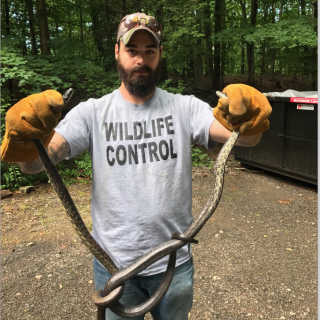Kristopher Zulkeski, Animal Control Warden

Ridgefield’s new Animal Control Warden, Kristopher Zulkeski, is a fascinating young man with a very special connection to animals. A graduate of Norwalk High School, Zulkeski started as a mortarman in the U.S. Army and served his country for six years. From 2009 to 2010, he did a tour of Afghanistan. When he returned home from the service he worked part time for Weston Animal Control for four years and then went into his own fully licensed wildlife control business. Zulkeski believes that we have to learn to coexist with animals and not just try and always remove them.
Zulkeski recommends that, “We become aware of the different seasons and how animals operate during each season. For example, new babies of fox and raccoon are born in the spring. Mating season for the deer is in the fall and that is why they are then more visible and active. “
“I am an advocate of photographing wildlife and not disturbing their life style unless they are regularly endangering your family and pets. I also advise people not to feed animals at any time. When feeding animals you are disrupting their regular feeding cycles, giving them a false sense of comfort and threatening their life in the wild.”
It is rare when Zulkeski cannot handle a particular wildlife situation, but when he needs assistance he calls DEEP (the Ct. State Department of Energy and Environmental Protection.) This agency is most often used in connection with particularly troublesome black bears, coyotes, and bobcats.
People often ask Zulkeski why we have two animal shelters in town, right across the street from each other. Zulkeski explains that both ROAR and Animal Control work closely together, but have two entirely different purposes. One is to find forever homes for homeless animals and Zulkeski’s shelter is to deal with animals in a difficult interaction with people or another animal.
A strong advocate of a Wildlife Box for every home, Zulkeski prefers using a water tight box that can be kept outside. Inside the box should be a coffee can with some coins. The sound that comes from shaking the coins in the can is able to scare off something as big as a black bear or as small as a squirrel. In the container should also be an air horn or whistle whose sounds will ward off animals, and possibly bear mace, if bears are regular visitors.
To better understand how to handle situations with wild animals or even domestic animals, Zulkeski suggests having him speak, along with Jennifer Bradshaw, from the Woodcock Nature Center. These two animal experts are available to go to various organizations to provide participants with an understanding of how animals can best be handled in a way that benefits both the humans and the animals.
Zulkeski would rather meet people in an educational setting talking about animals, then when a person has a problem. Then if a problem does arise, a relationship has already been established.
Research is another aspect of Zulkeski’s job. He wants to track the population of various wild animals in Ridgefield so that he can predict trends. He wants to discover if animals are traveling alone or in packs and what seems to be their source of nourishment. Synthesizing all of this information, is helpful in making recommendations to the town.
Zulkeski’s love of all animals started at age six when his father brought home a young Columbian red tailed boa that eventually grew to nine feet. Along with this snake and other snakes that were housed in his bedroom, were tanks with tokay geckos, monitors, legu’s, chameleons, and assorted other animals. By carefully observing and caring for his menagerie, Zulkeski learned about the unique characteristics of each animal. It was not long before Zulkeski’s hobby turned into a full time career of observing, learning, and working with animals in every type of situation possible.
When asked about his favorite pet as a child, Zulkeski said, “Probably my favorite pet was a euromastyr. This lizard like animal looked a lot like a dinosaur. It reminded me of animals that I saw in the movies and in books. My own children, Noah (6) and Brooke (4), love bats, all kinds of birds, raccoons, dogs and rounding up the pigs. They have been taught since they were very young about the boundaries we need to follow with animals. They look forward to me coming home each day to see if I am bringing any type of animal for them to learn about.”
Due to being a type of “animal whisperer” with years of experience, Kulkeski says that he is able to, “walk a bear out of a yard, separate a mother raccoon from its babies, or deal with a fox in a chicken coop. However, he advises others not to try any of these activities.”
In his spare time, Zulkeski loves to be in the out of doors, fishing, boating or doing yard work in his Ridgefield home. When working, most of Zulkeski’s calls deal with animal fights, a rabid animal, a dangerous or abandoned dog, a wounded animal that needs to be taken for help, an animal trapped in a house and finding the source so that the entrance to the house can be blocked, or a myriad of other situations.
The key to wildlife management according to Zulkeski is education, acting responsibly and not being fearful. You can call Kulkeski at any time of the day or night at his work number 203-431-2711 and you will be patched into his cell phone. Our new animal control officer looks forward to your calls as they make his life more interesting. Each call is somewhat different and each one is a challenge that he is ready to meet. Zulkeski rarely seems to have met an animal that he did not like or one with which he could not communicate effectively.

